Heading out the door? Read this article on the new Outside+ app available now on iOS devices for members! Download the app.
There’s a lot more to knives and tools than a sharp edge and a bottle opener attachment. And whether you’ll be slicing trail cheese or cutting through stubborn rope on a packraft, it pays to have a discerning eye when choosing the right tool for your trip. Our testers waded through a sea of stainless steel and gimmicky folding contraptions to find the very best pocket knives and multitools for splitting, hunting, wilderness repairs, and more.
Updated March 2025: We’ve added multiple new knives and multitools to our list. Prices and info for older picks have been updated for 2025.
At a Glance
- Best All-Around Knife: Benchmade Bugout (From $180)
- Lightest: SOG Ultra XR ($130)
- Budget Folding: CRKT Pilar ($40-$70)
- Best Fixed Blade: Gerber StrongArm ($100)
- Best Survival Fixed Blade: Outdoor Element Scout Feather ($50)
- Best All-Around Multitool: Leatherman ARC ($230)
- Lightest Multitool: SOG Powerpint ($40-50)
- Budget Multitool: Victorinox Huntsman ($52-$59)
- Best Gadget: Outdoor Element Firebiner ($15)
- How to Choose a Knife
- How We Test
- Meet our Testers
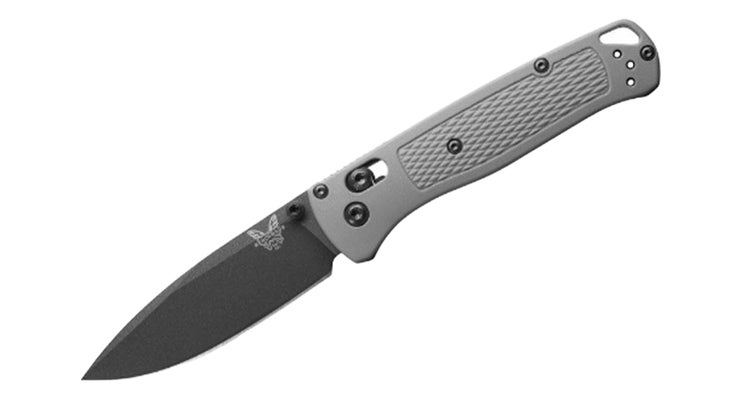
Best All-Around Knife
Benchmade Bugout
$180-200 at Amazon $180 at Scheels
Weight: 1.85 oz
Pros and Cons
⊕ Holds its edge
⊕ Very light
⊕ Customizable
⊗ Expensive
If it ain’t broke, don’t fix it. Year after year, Benchmade’s Bugout lands above the rest for its light weight (less than a candy bar) and class-leading durability. A chromium nitride coating adds a layer of rustproof protection that’s uncommon on knives in this weight class. The Bugout also has a unique, lightweight spring-bar lock, which is safer and longer-lasting than a traditional metal liner lock.
Our tester cut through zip ties, nylon rope, and thick sticks, but this drop-point blade never lost its edge thanks to premium S30V stainless steel. (Benchmade also has a free lifetime sharpening program.) Despite its slender profile, the grippy, diamond-patterned handle offers precision when slick, while the thumb stud operation is a cinch with one hand. “Even though the grip was covered in grease from a trailhead car repair, deployment was still easy because the studs near the blade produce a secure thumbhold,” said one tester.
Bonus: For a small cost, you can customize this knife, swapping out blade types, designs, and colors.
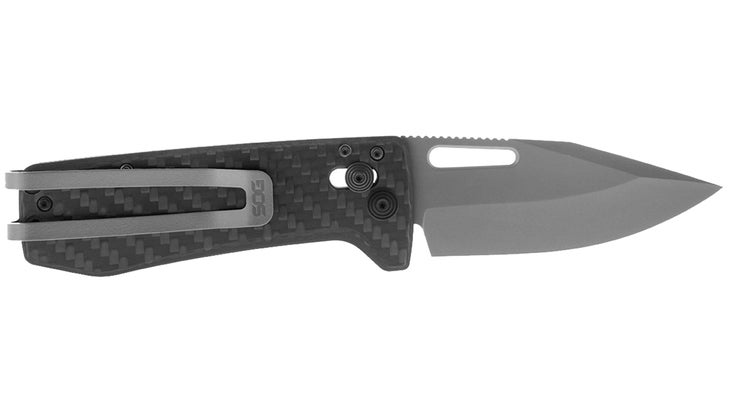
Lightest
SOG Ultra XR
Weight: 1.2 oz
Pros and Cons
⊕ Extremely lightweight
⊕ Thin
⊕ Holds its edge
⊗ Not ergonomic
At 1.2 ounces and 6.5 millimeters thick, the Ultra XR is one of the slimmest and lightest knives we’ve ever used. The high-quality, 2.8-inch stainless steel blade keeps its edge and resists chipping and corrosion.
One tester has used this knife for four years, utilizing it for camp duties like cutting kindling and food prep, and the blade is still nearly as sharp as the day it was made. He also lost this knife in the snow, unearthed it in spring, and reported that it still functioned without issue and had hardly any rust buildup.
An XR lock (SOG’s proprietary mechanism) allows single-handed opening, and is reportedly good for up to 1,500 pounds of pressure (we leaned hard on it without any flex.) The thin, carbon-fiber handle provides a decent-enough grip, but it’s a bit too narrow to be ergonomic, and the relatively large pocket clip causes irritating with prolonged use.

Budget Folding
CRKT Pilar III Frame Lock
$40-70 at Amazon $45-70 at CRKT
Weight: 3.5 oz
Pros and Cons
⊕ Three blade options
⊕ Affordable
⊕ Ergonomic handle
⊗ Relatively heavy
With a low price point and several options for blade type and color, the Pilar is an excellent entry point into the world of customized knives. Our tester noted that the 12c27 stainless steel edge stayed perfectly sharp for over 50 days of performing various tasks on a catamaran in the Mediterranean and backpacking in New Mexico’s Carson National Forest. He praised the Pilar III’s drop-point blade, which gave him precise control while cutting. He also appreciated the knife’s G10 and stainless steel handle and grip, which is textured with moon-like craters that help with slippage when wet. Our tester’s main complaint? The hole in the blade, used for opening and closing the knife, was a bit too small and made smooth, one-handed operation more difficult.
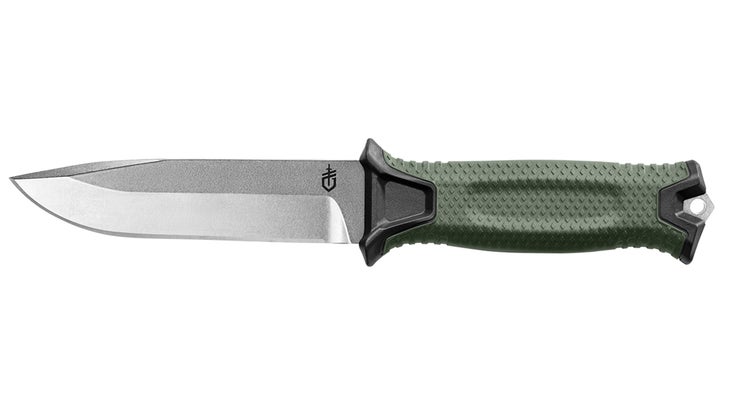
Best Fixed-Blade Knife
Gerber StrongArm
$100 at Gerber $90-100 at Amazon
Weight: 7.2 oz (without sheath)
Pros and Cons
⊕ Serrated and flat blade options
⊕ Excellent rubberized grip
⊕ Versatile sheath
⊗ Some sheath attachments are hard to attach
With exceptional grip, power, and dexterity, the Gerber StrongArm was a favorite for our bear- and elk-hunting New Mexico-based tester. An officer with the state’s Department of Fish and Game, she tested this full tang knife with its nearly 5-inch-long stainless steel blade and praised its strength while processing game. Delicate movements—like removing the bear hide without punching a single hole in it—were made easier thanks to the rubberized, textured grip, which never slipped, even while covered in blood. Even more impressive: the 420HC stainless steel blade cut through the leg of a bull elk to find a poacher’s bullet. After all the digging, jabbing, and cutting, the blade was still sharp as the day she received it, with no cracks or chips. The included sheath can be attached many ways, though she did note that it worked better on a belt or pack rather than vest given the real estate it takes up.
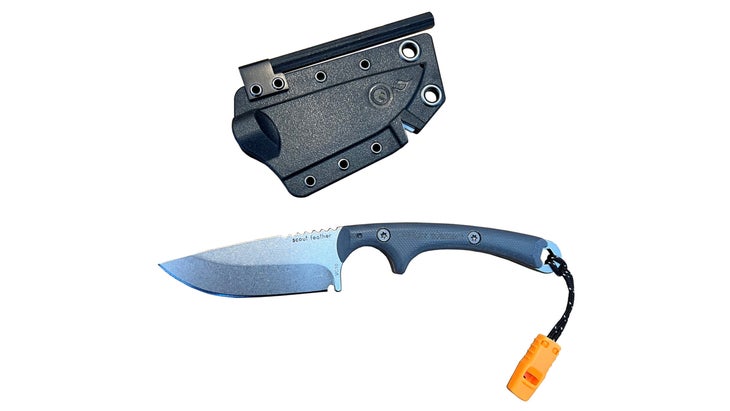
Best Survival Knife
Outdoor Element Scout Feather
Weight: 4 oz with sheath
Pros and Cons
⊕ Secure grip
⊕ Includes fire starter, whistle, and sharpener
⊕ Affordable
⊗ Doesn’t hold edge for long
At a total length of just 6.5 inches, this mini fixed-blade was ideal for our northern New Mexico tester who needed a knife for working in tight spaces and small areas, like cutting inside and around the hide of a bear’s head.
The thin, plastic handle has small, textured scales and a deep indentation for the index finger. Our tester was able to maintain a secure grip even with blood and animal grease on the handle. The sheath was easy to attach to belts with a rotatable pocket clip as well as packs and vests thanks to variously-sized grommets. (It has a neck-carry option too.) The sheath includes a fire-starter, whistle, and sharpener, the latter of which came in handy for our tester, who felt he needed to sharpen the VG10 stainless steel blade frequently after processing and skinning game.

Best All-Around Multitool
Leatherman ARC
$250 at REI $250 at Public Lands
Weight: 8.6 oz
Pros and Cons
⊕ One-handed open/close
⊕ Plentiful tools and bits
⊕ MagnaCut steel
⊗ Expensive
Leatherman’s “Free” tech—a magnetic one-handed opening mechanism that stays secure when folded—first debuted in smaller, simpler multitools back in 2019. Now, that hands-free tech is being used in the versatile Leatherman ARC, with its 20 tools, a 9-piece, double-ended drive set, and full-handle pliers.
The ARC sports a 2.76-inch blade, made with high-end MagnaCut steel and a handy thumb stud for simple deployment. Our tester, a retired engineer, claimed this palm-sized tool nearly replaced his home tool box. “I was able to unscrew a corroded motor connector, clip off the fastener, file down the terminal to bare metal, and strip the wire.”
The nylon sheath with its snap closure and belt loop is a bit bulky for backcountry travel, but does hold the tool and bit set, with a separate compartment for each. Ding: At $230, the ARC’s top-of-the-line build doesn’t come cheap.
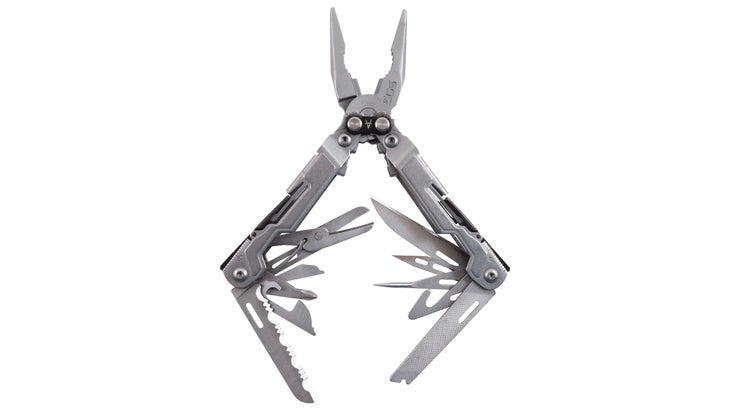
Lightest Multitool
SOG PowerPint
Weight: 4.2 oz
Pros and Cons
⊕ Very light
⊕ Many attachments
⊕ Great pliers
⊗ Very small tools
Ounce for ounce, the PowerPint is one of the most useful multitools we’ve tested. It stuffs 18 functions into a package that weighs less than a magazine, and pairs them with smart design: locking mechanisms for each individual tool and access to the file, can opener, screwdrivers, saw, and blades—all without opening the pliers.
The scissors, in particular, were a highlight. They kept their sharpness after a season of use cutting everything from moleskin to a thick, aluminum stove wind-break without fail. One Tester praised the PowerPint’s strength: “I put a lot of pressure on the pliers while I was repairing a stove, but they held up.” Another used it to carefully pull cactus needles out of their dog on the River Place Canyon Trail outside of Austin, Texas. “This tool has the smoothest action I’ve ever seen,” reported a third. “While fashioning a hasty fishhook out of barbed wire, I was able to open, operate, and close the pliers with just one hand while I held the rod with the other.”
One tester did note that the tradeoff for such a compact, versatile contraption is that the tools are very small, which translates to underperformance compared to some of its scaled-up competitors, like the Leatherman Arc or Victorinox Huntsman.
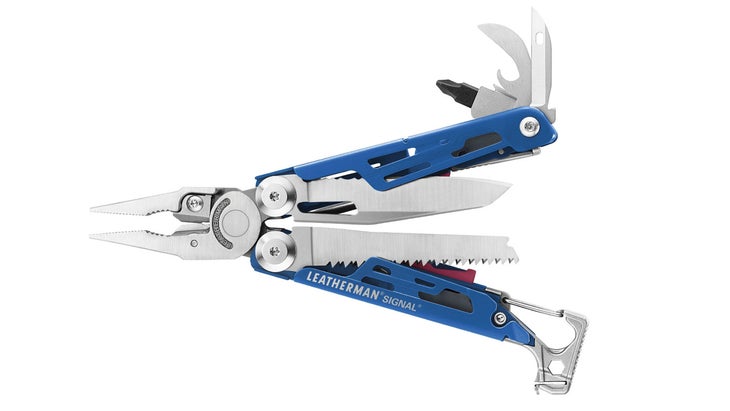
Paid Advertisement by Backcountry.com
Leatherman Signal Multi-Tool
Be prepared to fix anything with Leatherman’s Signal Multi-Tool. Perfect for camping, hiking, and backpacking, this compact multi-tool will help you build fires, prepare food, repair gear, call for help, and more. Its nineteen tools include a blade with serrated and straight edges, multiple pliers and cutters, a saw, hammer, diamond-coated sharpener, and a ferro rod for starting fires. Plus, you’ll find a wire stripper, awl, drivers, wrenches, a safety whistle, and openers for cans and bottles.
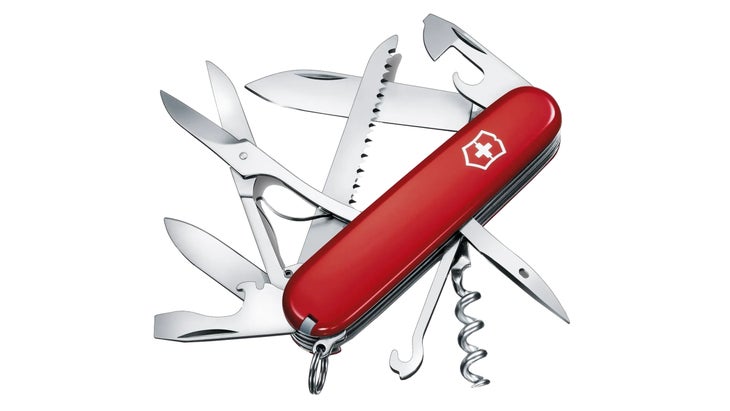
Best Budget Multitool
Victorinox Huntsman
$52 at REI $52-55 at Victorinox
Weight: 3.4 oz
Pros and Cons
⊕ Lightweight
⊕ 15 tools
⊕ Many color options
⊗ Non-locking
Instantly recognizable as the original multitool, the fire engine red Victorinox Huntsman still holds up today. The $52 price tag seems to have withstood the forces of inflation as well. But this isn’t your grandparent’s Swiss Army Knife. The modern Victorinox is now made of stainless steel rather than carbon steel, and the corkscrew, awl, small blade scissors, and driver are all better-designed than the original.
A multipurpose hook makes pulling tent stakes out of the ground a cinch. Our Alaska-based tester loved that the awl tool has a small opening that allowed him to punch a hole in his pack with threaded string to fix his shoulder strap. “I never thought an awl would be useful, but I’m so glad I had one.”
Our tester did wish the tools—and especially the knife—would lock and that they could be accessed one-handed. He complained that some tools are even hard to get out with two hands. But overall, it’s a solid, affordable tool that’ll get you out of just about any jam. The lifetime guarantee means it’ll stay functional for future generations, too.

Best Atypical Multitool
Outdoor Element Firebiner
Weight: 1 oz
Pros and Cons
⊕ Very lightweight
⊕ Reliable Firestarter
⊗ Not rated for climbing
Everyone loves a carabiner. A carabiner that doubles as one of the 10 Essentials? We couldn’t resist. The stainless-steel Firebiner will bring out your inner caveman: It has a built-in spark wheel with a 2,000-strike capability. It also has a flathead screwdriver and bottle opener, plus a safety blade notch that cuts through cord and fishing line.
The biner isn’t rated for climbing, but is perfect for hanging gear, clothing, or a light in your tent or camping area. “The Firebiner is basically foolproof, and it always throws a spark with the first spin,” said one tester. “It’s easier than most dedicated firestarters I’ve used, and after 5 years of use it still functions like it did on day one.”
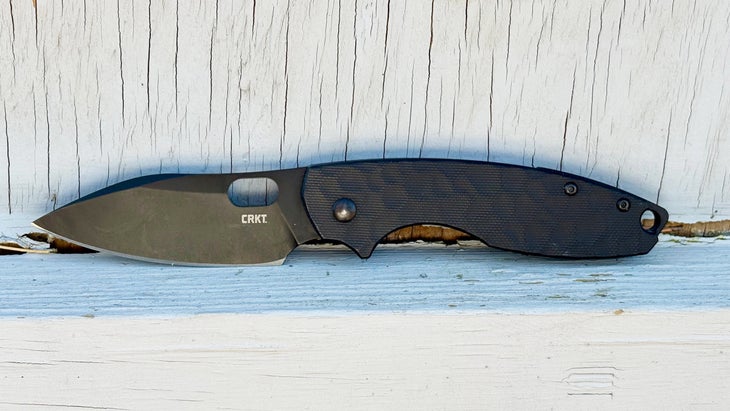
How to Choose a Knife
Fixed or Folding?
The biggest decision for any backpacker in search of a new blade is choosing between folding pocket knives—made with moving parts to open and close the blade from the handle—and fixed-blade knives, typically a single piece of steel or carbon fiber kept in a sheath.
- Folding knives are much smaller and often lighter when packed, and occasionally come in multi-tool bundles that are helpful for some, but offer too much for others.
- Fixed-blades are heavier and less compact, but are stronger and tend to last longer. In emergency situations, a heavy fixed-blade has the added benefit of being able to split wood for a fire.
Blade Shape
A drop-point-blade (a convex curve following a straight spine) is the most common shape among backpackers and hunters for good reason—its utilitarian slope is versatile, keeps the blade cleaner than the sharp angles of something like a tanto, and is less likely to break (or accidentally cut you) than a clip point.
If you are climbing or packrafting—which potentially involves cutting ropes in unstable positions—consider a sheepsfoot blade, which minimizes the potential for a accidental punctures.
Accessibility
Folding knives sometimes come with one-handed or assisted openings to make it easier to release the handle (helpful when you have your hands full.) They can be more expensive and dangerous if you’re not careful, but many folding knives also include a lock to prevent the blade from folding in on itself.
Types of Stainless Steel
All the blades we tested are some type of stainless steel. Chromium is the magic element that gives this iron-carbon alloy a leg up on resistance to rust and corrosion, and the caliber of stainless steel affects how well the blade’s edge holds up.
A few common varieties:
- S30V: Most knives (including various Gerber models) use this type of stainless steel. It is resistant to corrosion, tough, and holds its edge well.
- S35VN: With a slightly different composition to the S30V steel, S35VN offers more toughness and can take a little more stress without breaking.
- CPM-M4: This superhard steel has very good edge retention and is common in Benchmade knives.
- Magnacut: This stainless steel is newer to the market. It comes at a premium price and has the highest wear-resistance of the bunch. The Leatherman Arc features this steel.
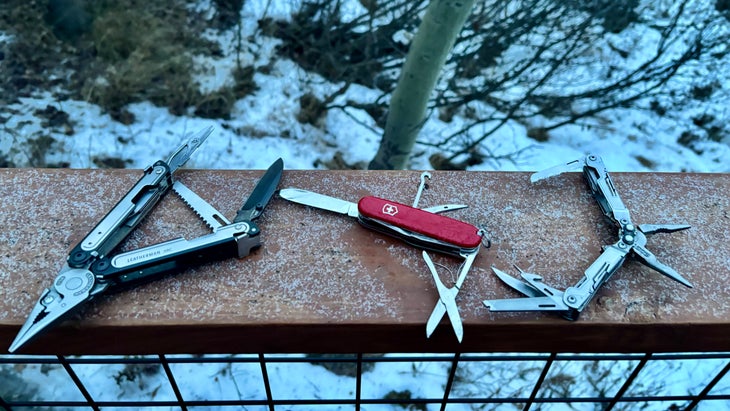
How We Test
- Number of testers: 21
- Number of products tested: 34
- Number of states tested in: 13
- Countries tested in: USA, Canada, Thailand, Spain, Turkey
- Toughest task: Digging a poacher’s bullet out of an elk
Our testers hail from all over the United States, but ventured out to far-flung locations in order to put 34 new, updated, and tried-and-true blades through their paces. Between car camping, backpacking, fishing, and hunting, the knives and tools whittled, spliced, and diced with the intent to dull the blades. Through the years, we continue to assess durability, ergonomics, weight, sharpness, functionality, edge retention, and aesthetics to choose the best of the best.
Meet Our Testers
Justin La Vigne has served as Backpacker’s lead tester of knives and tools for eight years. Living in a small cabin next door to Denali National Park and Preserve in Alaska, he prides himself on his nontraditional work. When not writing, he is a professional backcountry guide, taking people hiking and backpacking all over Alaska. His next adventure will be an attempt to climb Mount Kilimanjaro as part of the non-profit team “My Impossible.”
New Mexico tester Jeff Laskie, a self-professed gadget nerd, has been part of the testing team for 6 years. As Assistant Hatchery Manager for New Mexico Game and Fish, he always needs a blade handy for his work. When not raising New Mexico’s state fish (Rio Grande Cutthroat) to restore them to their native waters, he is outside hunting with traditional archery equipment and flintlock muzzleloaders.
Related
The Best Hiking Boots for Men
The Best Backpacking Tents
The Best Backpacking Sleeping Bags